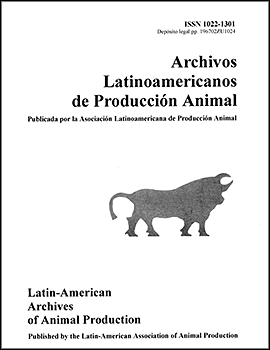
|
Archivos Latinoamericanos de Produccion Animal
Asociacion Latinoamericana de Produccion Animal
ISSN: 1022-1301
EISSN: 1022-1301
Vol. 13, No. 1, 2005, pp. 1-12
|
 Bioline Code: la05001
Bioline Code: la05001
Full paper language: Spanish
Document type: Research Article
Document available free of charge
|
|
|
Archivos Latinoamericanos de Produccion Animal, Vol. 13, No. 1, 2005, pp. 1-12
| en |
Effects of cutting frequency, row spacing and nitrogen fertilization in Digitaria eriantha  cv. Irene cv. Irene
Abstract
During the yearly cycles 2000-2001 and 2001-2002 an experiment was conducted with the perennial grass, Digitaria eriantha cv. Irene, at Bahía Blanca (Argentina). In randomized blocks-design with three replications and a 2 × 2 × 3 factorial arrangement of treatments, the factors studied were: 1) cutting frequency: continuous, whenever the plants reached a height of 26-28 cm; and seasonal, with one cutting at the end of spring and of summer; 2) row spacing: 30 and 50 cm; and 3) levels of nitrogen fertilization: 0, 50, and 100 kg/ha. Forage harvested in spring and summer was weighed to determine dry matter yields per season and annual total (MS, kg/ha). Crude protein content (% PC), CP yield (kg/ha), efficiency of N utilization (ENU, kg MS/kg N) and N recovery in forage (% NR) were also determined. Fertilization was the most influential factor in addition to rainfall. Mean total yields of DM with 0, 50, and 100 kg N/ha were, in drier 2000-2001: 1632, 2122, and 2539 kg/ha, and in rainier 2001-2002: 2564, 4474, and 4708 kg/ha, respectively. Mean of CP of both years for the same N levels, were 6.8, 9.0, and 10.7, respectively. Yields of CP were also highest with 100 kg N/ ha, but ENU and NR were better with the lower level of N application. This result suggests that N fertilization at a level close to 50 kg/ha is recommendable. Continuous cutting reduced forage yields (P<.05), but gave higher % CP relative to seasonal cutting (P<.05). Row spacing had no consistent effect on these variables, but 30 cm is favored to reduce soil erosion.
Keywords
Digitaria, dry matter yields, forage quality, fertilization.
|
| |
| es |
Efectos de la frecuencia de corte, distancia de siembra y fertilizaciónnitrogenada en Digitaria eriantha  cv. Irene cv. Irene
Resumen
Durante los ciclos 2000-01 y 2001-02 se realizó un ensayo con Digitaria eriantha cv. Irene en Bahía Blanca (Argentina). Con un diseño factorial 2×2×3 en bloques aleatorizados y tres repeticiones se estudiaron: 1) frecuencia de corte: continuo, cada vez que las plantas alcanzaban 26-28 cm de altura; y estacional, con cortes al finalizar la primavera y el verano, 2) distancia de siembra: 30 y 50 cm, y 3) niveles de fertilización nitrogenada: 0, 50 y 100 kg/ha de N. El forraje cosechado en primavera, verano y total anual fue pesado a fin de calcular los rendimientos de materia seca (MS, kg/ha). Además, se determinaron el contenido de proteína bruta (PB, %), rendimientos de MS proteica (MSP, kg/ha), eficiencia de utilización del N (EUN, kg MS/kg N) y recuperación del N (RN, %). En relación a la precipitación pluvial, el fertilizante fue el factor más influyente. Los rendimientos de MS promedios totales con 0, 50 y 100 kg/ha de N, fueron en 2000-2001 (ciclo mas seco): 1632, 2122 y 2539 kg/ha, respectivamente, y en 2001-2002 (ciclo mas lluvioso): 2564, 4474 y 4708 kg/ha, respectivamente. Los contenidos de PB promedio de ambos ciclos, para los mismos niveles de N, fueron 6.8, 9.0 y 10.7%, respectivamente. Los rendimientos de MSP fueron mayores con 100 kg N/ha, pero EUN y RN fueron mejores al menor nivel de aplicación de N. Estos resultados sugieren la fertilización con N a una dosis próxima a los 50 kg/ha. Los cortes continuos redujeron los rendimientos de forraje (P < 0.05), pero el porcentaje de PB fue mayor respecto de los cortes estacionales (P < 0.05). La distancia de siembra no tuvo un efecto consistente, pero se favorece la de 30 cm para mejorar la protección del suelo.
Palabras-clave
Digitaria, rendimientos, calidad forrajera, fertilización.
|
| |
© © 2005 - ALPA. Arch. Latinoam. Prod. Anim.
Alternative site location: http://www.alpa.org.ve/ojs/index.php
|
|
